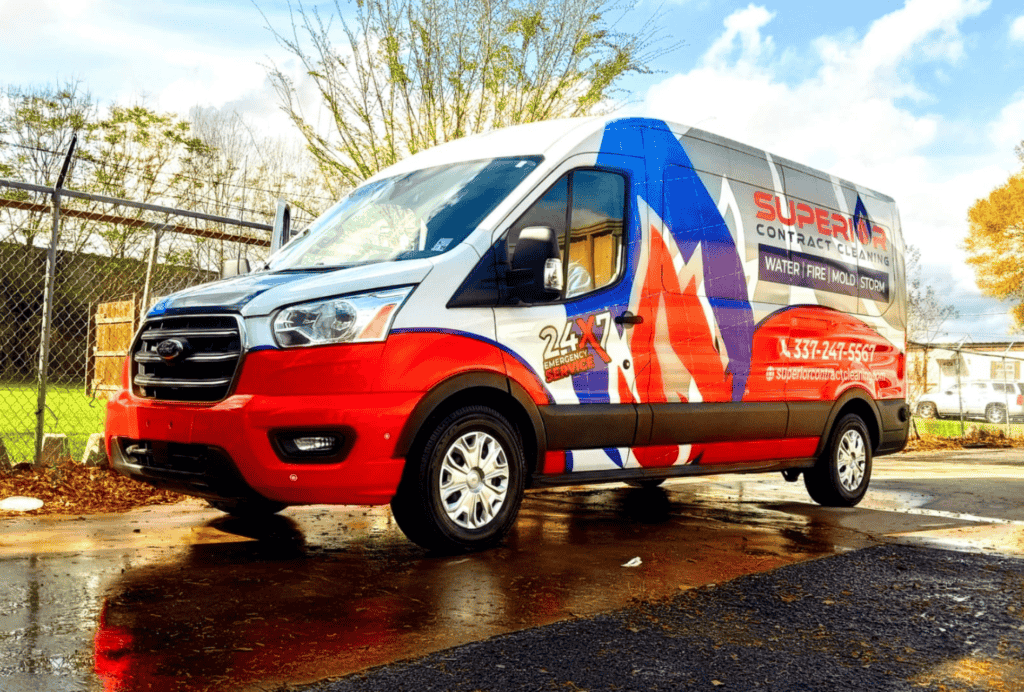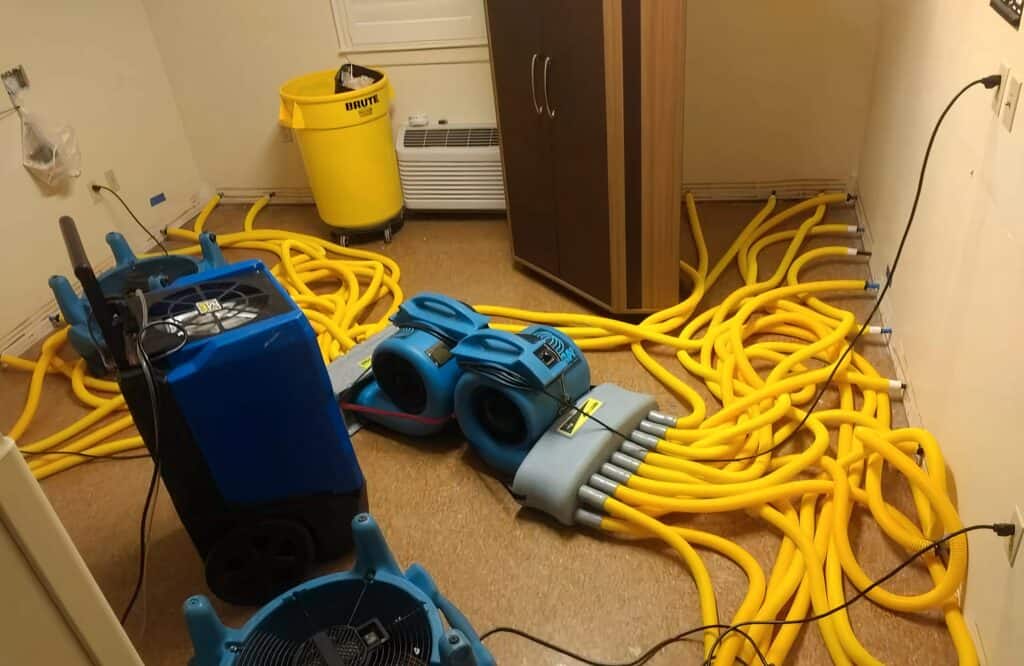How Much Does Water Damage Restoration Cost?
Find out the average costs of water damage restoration and what determines those costs.

Written By Rinea Blanchard
Written and fact-checked by an industry expert. ✔️

Average Water Damage Restoration Costs
We typically bill our water damage restoration customers $2,500-$5,000 for water damage restoration.
You may have read certain articles online about water damage restoration services costing $7,000, $10,000, or even more, but those aren’t always accurate because the costs are also determined by your location.
Higher-tax states and more expensive cities will, consequently, have more expensive services like water, fire, and mold restoration.
But, in Acadiana, where we’re based, the costs of living are around 12% lower than the national average, which helps us charge a little less for our services.
However, the cost of living is not the biggest factor that determines the cost of water restoration. There are many others, and we’ll cover them in this article.

What Determines Water Damage Restoration Costs?
Quick Answer
Water damage restoration costs are mostly determined by the extent of the damage, materials affected, and the contamination levels of the water itself.
In a nutshell, the harder the damage is to restore, the more labor is required, leading to higher costs.
Let’s now get into the factors that determine the “difficulty” of water damage restoration.
Water Damage Class
Water damage “class,” or simply put, the extent of the damage, is a term from the Institute of Inspection, Cleaning, and Restoration Certification (IICRC) that helps measure how much damage the property endured from the water or flood.
There are four water damage classes, ranging from less severe to more severe.
- Class 1 Water Damage: Water damage doesn’t extend to one corner of one room and is less than 12 inches in height.
- Class 2 Water Damage: Water damage reached 12 inches and has spread throughout the entire room.
- Class 3 Water Damage: Multiple rooms have now been damaged, with all essential materials being damaged: subflooring, drywall, and ceilings.
- Class 4 Water Damage: The most severe water damage, usually brought on by natural disasters. Concrete, wooden beams, and the foundation of the property all likely require extensive repairs.
To put it in perspective of how much the prices can range, class 4 water damage can cost five or even six figures to restore in extreme scenarios.
These would be severely flooded or even completely destroyed properties, where restoration can take over a year to fully complete.
But still, most consumers will face classes 1 and 2, where the costs are less likely to exceed $5,000, unless the water is severely contaminated, which leads us to the next factor.
Water Damage Category
Similarly to classes, water damage categories have been documented by the IICRC in their S500 standard.
There are three water damage categories:
- Category 1 Water Damage: Also known as “clean water,” category one is typically very “safe” to be around without any protective material, as the water usually originates from rain or snow or indoors from water supply line pipes.
- Category 2 Water Damage: “Grey water” is slightly contaminated and could cause problems if consumed (not that you plan so, but it’s worth pointing out), and it usually comes from appliance leaks full of chemicals, sump pump overflows, and “clean water” that has been stagnant for over 48 hours. Grey water can also contain dirt, soil, and dust.
- Category 3 Water Damage: “Cat 3” water damage, also known as “black water,” is the most hazardous water by the levels of contamination, originating from sewage and flooding. Black water can contain urine, feces, dead animals, trash, and even seriously hazardous objects (like glass or other sharp items) that can cause severe injury upon contact.
The more “dirty” the water is, the more work will it take to disinfect and sanitize. This demands more labor and cleaning supplies, leading to higher costs.
In general, we bill more for sewage cleanup and flood damage restoration than we do for appliance leak repair, bust pipe repair, or sump pump overflow cleanup.
Types of Materials Damaged
Certain materials, depending on the situation, may require extensive repairs or even complete replacements.
Obviously, the more the merrier; if we need to replace an entire drywall because of a leak, that will be added to your bill.
Porous items are usually the ones that go out first, but if the situation is severe, your entire property may need extensive work:
- Drywall: Drywalls need to be replaced if they get just 1% wet. They’re one of the most sensitive structural materials to dampness and water damage.
- Insulation: Insulation is also porous and very likely to get damaged beyond repair during a flood or a more severe leak.
- Hardwood flooring: Our wooden floors can tolerate a simple glass spill, but if they absorb too much water, they can start to warp or buckle. At this point, the boards will most likely have to be replaced.
- Carpets: Soaked-up carpets usually can’t be dried out and cleaned; they will have so much contamination and mold that replacing them would be a must.
- Electrical system: Using your electrical system after water damage can be extremely dangerous. There is a risk of electrocution, short-circuits, and more. If the water has reached your sockets and cables, stay away from it at all costs.
Is Water Damage Covered By Insurance?
Yes, it typically very often is!
But, unfortunately, sometimes you may not be able to get coverage, mostly depending on the source of the water.
Here’s a quick summary:
- Sudden, abrupt, and accidental water damage is usually covered by insurance. By “accidental,” they mostly mean that the damage happened due to a reason completely out of your control. This typically includes appliance leaks and suddenly-burst pipes.
- Non-accidental, preventable water damage is usually not covered. By this, the insurance typically considers any damage that you could have realistically prevented; cases where the damage may have originally started as a small leak that gradually grew into a bigger issue a few weeks or months later.
- Flood damage is usually NOT covered; it typically requires a separate insurance policy.
- Sump pump overflows, sewage backups, and other backups are usually NOT covered; they may also require additional coverage.

Can I Fix Water Damage Myself?
Want to save some money and DIY the entire project?
Well, if you’re fine with completely neglecting and risking your health, then go ahead.
There’s a reason why restoration companies charge as much as they do. Water restorers undergo extensive training before they start taking on client projects.
A lot of potential health hazards are present in water-damaged properties (disease, electrocution, certain structures collapsing, etc.).
Then there’s the knowledge that’s required to determine whether an item should be repaired or replaced, among many other things.
Don’t do it. Call us, and we’ll try our best to negotiate good coverage on your behalf.
Summary
Water damage restoration costs usually fall between $2,500 and $5,000, with a high possibility of them being covered by insurance.
The extent of the damage, along with contamination levels and the types of materials affected, determine these costs.
You shouldn’t try to DIY water damage restoration, as you could get seriously hurt or get sick.
Call Superior Contract Cleaning instead! Dozens of 5-star reviews don’t lie; we know what we’re doing. Emergency responses are available throughout the entire Acadiana region.
